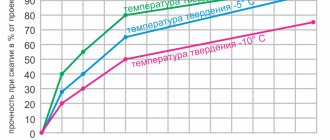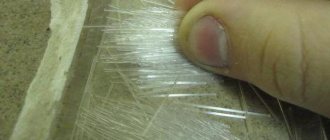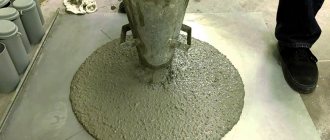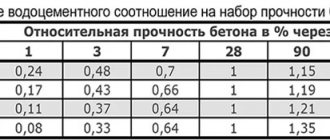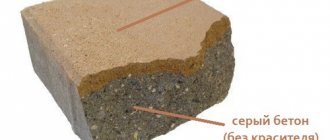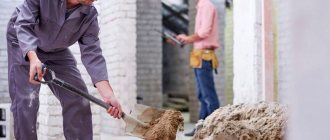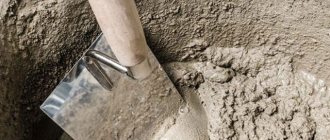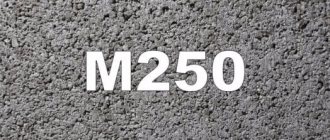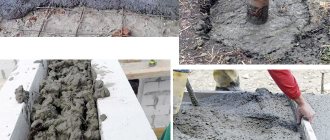Waterproof non-shrinking cement is one of the most widely used types of cement mixtures, as it greatly facilitates certain types of construction work. It is used when it is necessary to obtain a concrete coating that does not allow moisture to pass through.
This type of cement mixture is characterized by a rapid setting process (the beginning of setting begins a few minutes after connection, and ends no later than 5-10 minutes). In this case, the mass quickly hardens, reaching about 60-80% of the total brand strength by the end of the third day. The resulting cement stone has high moisture resistance and is able to withstand water pressure of 0.7 MPa.
Manufacturing process
Initially, waterproof non-shrinking cement was created on the basis of another mixture - aluminous. The basic raw materials for cement are bauxite and limestone, which are mined, among other things, on the territory of our state. The principle of operation of a waterproof non-shrinking mixture is that when the solution hardens, the process of crystallization of calcium aluminates occurs, under conditions of counteraction to the free expansion of the solution. This affects the significant compaction of the cement stone, as a result of which it becomes waterproof and acquires waterproofing qualities.
Non-shrink cement is produced in factories by grinding alumina-type cement with calcined lime and gypsum. If the volumes of gypsum and lime can vary, then the amount of cement should be 85% of the total mass. Addition of asbestos is allowed (no more than 5%).
A well-prepared cement stone becomes moisture-proof after an hour, and fully activates all its properties after 28 days.
Application
Waterproof non-shrinking cement is used when pouring foundations that are not subject to water filtration. Indispensable for installing floors in garages, basements, and cellars where isolation from contact with groundwater is required. I use this cement to fill the walls of cesspools so that the contents do not get into the groundwater.
The material is indispensable in the construction of swimming pools and decorative ponds. Can be used for waterproofing tunnels, to create an insulating layer on large reinforced concrete objects. Suitable for sealing cracks and joints in panel buildings.
Also, using a cement mixture, you can make a waterproof screed on the roof of a basement or garage, if the latter is located underground.
Aluminous cement is a fast-hardening and high-strength hydraulic binder obtained by finely grinding clinker containing predominantly low-basic calcium aluminates. Monocalcium aluminate determines the rapid hardening and other properties of aluminous cement. It also contains small amounts of other calcium aluminates and calcium aluminosilicate - gehlenite. Calcium silicates are represented by a small amount of belite.
To obtain aluminous cement clinker, a raw mixture composed of limestone and bauxite is subjected to sintering (at a temperature of about 1300C or melting (at 1400C). Aluminous clinker is more difficult to grind than Portland cement clinker, so more electricity is spent on grinding. In addition, bauxite is valuable raw material used for the production of aluminum.These and other circumstances increase the cost of aluminous cement and limit its production.
Aluminous cement has high strength if it hardens at a moderate temperature (not higher than 25C), therefore aluminous cement cannot be used for concreting massive structures due to heating of the concrete, and also cannot be subjected to heat and humidity treatment.
If the temperature of the concrete exceeds 25-30C, then a transition of dicalcium hydroaluminate into cubic tricalcium hydroaluminate is observed, which is accompanied by the occurrence of internal stresses in the cement stone and a decrease in the strength of concrete by 2-3 times.
A remarkable property of aluminous cement is its unusually rapid hardening. Grades of aluminous cement, determined based on the results of testing 3-day-old samples: 400, 500 and 600. Already after 1 day, aluminous cement gains high strength.
T A B L I C A. strength indicators of aluminous cement.
| Brand of aluminous cement | Ultimate compressive strength, kg/cm (MPa), not less | ||
| In 1 day | After 3 days | ||
The beginning of setting of aluminous cement should occur no earlier than 30 minutes (for Portland cement no earlier than 45 minutes), and the end should occur no later than 12 hours from the start of mixing.
The heat release of aluminous cement during hardening is approximately 1.5 times greater than the heat release of Portland cement (250-370 kJ/kg).
Aluminous cement is used in special structures, during urgent repair and installation work, and for the production of heat-resistant concrete and mortars. In addition, it is a constituent of many expansive cements.
Non-shrinkage concrete in Moscow
Application thickness in one layer is from 20 to 40 mm. A non-shrinkage, quick-hardening dry mix of thixotropic type, containing polymer fiber, intended for structural repair of concrete and reinforced concrete.
Triblock Finish is a three-component epoxy-cement system consisting of cement-based binders and epoxy resin in a water dispersion. What about other signs? Movie theaters get more revenue from popcorn sales.
Facts about cinemas. A woman lost weight so that her husband's friends would not bully him for choosing a fat wife. The girl was kicked off the flight because she admitted to being allergic to nuts.
The brother decided to stand up for the girl. The next day he was fired from his job. The fabulous life of a fabulous actress. Where did Lydia Vertinskaya end up from the screens?
Concrete is heavy. Concrete, reinforced concrete general issues. Shrink-free fine-grained. Pages: 1.
Future monarchs: what the heirs of European royal houses look like. The girl came to visit the guy. His mother yelled at her when she found out the reason for her sadness. Luxury houseboats and design ideas if you dream of living on the water.
Home Home comfort Repair.
offers high-quality dry construction mixtures for the production of non-shrinkable concrete and mortars. High-flow non-shrinking composition for high-precision anchoring of equipment and metal structures 3 - 60 mm. Expanding, fast-setting, flowable concrete mixture for anchoring equipment.
Let's talk in more detail about what it is and how to use it. Anna Kirnitskaya September 9, Comments 0. New Discussed Popular.
I want to receive. New comments to your personal account.
Types of waterproof cements
Non-shrinkage, fast-hardening dry concrete mixture of poured type, containing flexible metal and polymer fiber. Non-shrinkage, fast-hardening dry concrete mixture of thixotropic type, containing flexible metal and polymer fiber. Filling thickness from 10 to 50 mm. A gray, fine-grained, thixotropic-type repair mortar with a reduced modulus of elasticity, containing a light filler and designed to eliminate defects with a depth of 5 to 30 mm.
Ultra-fast-hardening dry cement mixture for eliminating leaks in concrete structures. Curing for 30 seconds.
Payment for the order
Fast-hardening cement-based mortar for quick installation of parts in underground construction. A two-component polymer-modified pourable dry concrete mixture intended for the repair of concrete pavements. Fast-hardening, high-strength polymer-modified dry concrete mixture with a reduced elastic modulus. Cement-binder, enriched with fiber additives, an alternative to concrete material for profiling and covering large-format concrete bases, used in the process of repairing concrete structures in accordance with ZTV-SIB and in accordance with the instructions of DAfStb.
Adhesive compositions based on hydraulic binders.
Expanding and non-shrinking cements.
Portland cement stone, when hardened in air, dries out and undergoes shrinkage, which often causes shrinkage cracks. In order to tightly seal the seam between prefabricated structural elements and obtain a practically impenetrable solution, or concrete, it is necessary to use a binder that, after mixing in the initial period of hardening, can increase its volume without structural damage. Expanding cements have controlled expansion, which, when manifested in cramped conditions, causes self-compaction of the cement stone (and concrete). Mortars and concretes based on expanding cements are practically impermeable to water and petroleum products (kerosene, gasoline, etc.), which, due to low surface tension, easily seep through the capillary pores of Portland cement stone.
Waterproof Expanding Cement
(developed by V.V. Mikhailov) is a quick-setting and fast-hardening hydraulic binder. It is obtained by thoroughly mixing aluminous cement (~70%), gypsum (~20%) and ground specially prepared highly basic calcium hydroaluminate (~10%).
Gypsum alumina expanding cement
(developed by I.V. Kravchenko) is a fast-hardening hydraulic binder obtained by joint fine grinding of high-alumina clinker or slag and natural gypsum dihydrate (up to 30%) or by thorough mixing of the same materials, crushed separately. Gypsum-alumina cement has the property of expansion when hardening in water; When hardened in air, it exhibits non-shrinking properties. It is used for grouting joints of prefabricated structures, waterproofing plasters, dense concrete in reinforced concrete shipbuilding and in the construction of tanks for storing petroleum products.
Expanding Portland cement
— a hydraulic binder obtained by joint fine grinding of the following components (% by weight): Portland cement clinker 58-63; aluminous slag or clinker 5-7; gypsum 7-10; granulated blast furnace slag or other active mineral additive 23-28. Expanding Portland cement is characterized by rapid hardening under short-term steaming conditions, high density and water resistance of cement stone, as well as the ability to expand in water and in air with constant moisture during the first 3 days.
Tensile cement
(developed by V.V. Mmikhailov), consists of 65-75% Portland cement, 13-20% aluminous cement and 6-10% gypsum; its specific surface area is not less than 3500 cm/g. In the process of expansion under certain hardening conditions, this cement creates prestress in the reinforcement, regardless of its location in the reinforced concrete structure. Consequently, the chemical energy of the binder is used to produce prestressed structures without the use of mechanical or thermal methods that require special equipment.
Depending on the achieved self-stress energy, determined by a special method and expressed in MPa, the following are distinguished: NC=2, NC=4 and NC=6. The beginning of setting of NC should occur no earlier than 30 minutes and the end - no later than 4 hours after mixing. Tensile cement hardens quickly, the compressive strength of NC after 1 day should be at least 15 MPa, after 28 days of hardening - 50 MPa.
Self-stressed reinforced concrete structures on NC are characterized by increased crack resistance, therefore NC is used for gas-tight structures, gasoline storage facilities, underwater and underground pressure structures, and sports facilities.
The most common and one of the relatively inexpensive but high-quality binders is cement. This material is necessary in any construction: both private and industrial. That is why entire research institutes are busy developing and improving its production characteristics. For the construction of objects in special conditions, which include wet autumn and harsh winter, professional builders prefer the use of waterproof grades of cement.
RSAM additive for non-shrinkable concrete (Code: p001)
The introduction of the expanding additive RSAM in the process of preparing a concrete mixture regulates the expansion energy of the binder, which makes it possible to obtain concrete for prefabricated and monolithic construction with both compensated shrinkage and prestressing concrete with different self-stress energies, ensuring high quality products.
| RSAM activity indicators according to STB 2092-2010 | |
| Linear expansion, %, not less | 1.20 |
| Self-stress, MPa, not less | 1,71 |
| Applicability for drinking water tanks | Allowed |
Application of RSAM
- for the production of non-shrinkage cement according to STB 942–93, tensile cement grade NTs-1 or NTs-2 according to STB1335–2002, as well as for the preparation of concrete and mortars with compensated shrinkage;
- to increase the strength of heat-insulating autoclaved cellular concrete.
Physico-chemical indicators of RSAM
Appearance: free-flowing powder ranging in color from light beige to light brown. At the customer's request, it is possible to supply PCAM in the form of granules up to 25 mm long.
Density 2750 – 3000 kg/m3
Humidity no more than 0.1%
Grinding fineness: specific surface 320 - 550 m2/kg
Application of PCAM in the production of heat-insulating autoclaved cellular concrete
When adding 1 to 5% PCAM additive (by weight of dry components) to the cellular concrete mixture, a significant increase in strength is observed.
The greatest strength for cellular concrete with density grades D400 and D500 is achieved by introducing 5% PCAM additive into the raw mixture.
For cellular concrete of density grades D200 and D300, already with the introduction of 3% PCAM, a significant increase in strength is observed.
The increase in the strength of cellular concrete in the presence of the PCAM modifier compared to cellular concrete without a modifier is: 1.9 times for concrete with a volumetric mass of 400–500 kg/m3 1.5–1.6 times for concrete with a volumetric mass of 200–300 kg/m3.
This means that the use of the PCAM additive makes it possible to obtain the strength of cellular concrete with a density of 200–300 kg/m3 at the level of strength of non-additive concrete with a density of 500 kg/m3.
The developed compositions of cellular concrete with the addition of PCAM can be recommended for the manufacture of load-bearing and enclosing structures, as well as for thermal insulation structures. Cellular concrete is especially in demand today, since it is practically the only building material that makes it possible to produce a single-layer wall that does not require additional insulation.
Application of PCAM in the composition of mortar or concrete based on Portland cement
Description
The RSAM additive is a mineral additive that is introduced into ordinary additive-free Portland cement to obtain a binder with unique specific properties: non-shrinkage cement, tensile cement grade NTs-1 or NTs-2, as well as with compensated shrinkage.
Distinctive features
♦ The use of a binder based on Portland cement and the PCAM additive allows to improve the performance characteristics of concrete. At the same binder consumption, the introduction of the PCAM additive into the concrete composition significantly increases the strength, both in compression and in bending, and also increases frost resistance and water resistance and, most importantly, eliminates the problem of cracks.
♦ The main advantage of concrete with the PCAM additive is compensation of shrinkage or obtaining residual expansion and self-stress through the use of expanding components in the mineral part of the additive.
♦ The use of PCAM also ensures long-term preservation of the mobility of mixtures.
♦ The RSAM additive makes it possible to obtain high-strength fine-grained and heavy concrete with a compressive strength of 40...80 MPa, including high early strength up to 25 MPa at the age of 1 day; self-compacting concrete with a compressive strength of 50...80 MPa; lightweight concrete with a compressive strength of 45-65 MPa.
♦ Due to the self-compacting structure of the concrete stone and a significant reduction in the number of open pores, concretes based on prestressing cements have increased frost resistance, and due to the dense fine-grained structure, sulfate resistance.
♦ Concrete with PCAM has a high coefficient of adhesion to old concrete. This allows them to be effectively used in repair and restoration work and strengthening structures. All this makes it possible to provide increased operational properties of structures without high additional costs.
♦ When constructing massive structures, the use of the PCAM additive makes it possible to reduce the exotherm of concrete (due to minimal cement consumption to achieve the concrete strength class and water resistance grade corresponding to the design), as well as to ensure increased shrinkage and thermal crack resistance of structures.
Scope of application of concrete with PCAM
The use of such concretes is especially effective in structures and structures that are subject to high requirements for crack resistance, water resistance and durability :
— containers for various purposes, including sewage treatment plants, pumping stations and swimming pools;
— underground structures of buildings and structures, including subway tunnels;
— pressure and non-pressure pipes, including large diameters (up to 6 m);
- long-term structures - coverings of airfields, roads, bridges, stadium stands, foundations of artificial skating tracks and fields; floors of civil and industrial buildings, including workshops of meat processing plants;
— prefabricated monolithic suspended shells for coverings of large spans;
— lightweight concrete elements of residential buildings: walls, precast roof slabs, as well as balconies and loggias;
— monolithization of prefabricated foundations for powerful turbine units, protective structures against radionuclides, sealing of butt joints, repair and restoration work.
Technical characteristics of RSAM
A binder consisting of a mixture of PCAM additive with Portland cement (without mineral additives) provides at the age of 28 days a linear expansion of at least 0.05%, a self-stress of at least 1.0 MPa.
To obtain non-shrinkage or prestressing cement of a grade not lower than NTs-1, concrete and mortars with compensated shrinkage, the content of the PCAM additive should be taken from 10 to 15% of the total mass of cement and PCAM.
Guaranteed shelf life is 12 months from the date of manufacture. Store in covered, dry places. During storage, the safety and tightness of the packaging must be ensured.
Preparation of concrete with RSAM additive
The RSAM additive in the production of concrete does not require special equipment, since the introduction of the additive can be carried out according to the schemes for receiving, storing and supplying raw materials adopted at concrete mixing units.
The preparation of concrete (mortar) mixtures must be carried out only in mechanical mixers (manual mixing is not recommended). When preparing a concrete (mortar) mixture, PCAM can be introduced into the mixer with both Portland cement and crushed stone and sand. But at the same time, it is necessary to ensure thorough mechanical mixing and precise adherence to the specified ratio with Portland cement by weight. When preparing concrete (mortar) mixtures with PCAM, it is also possible to additionally use other additives (plasticizing, antifreeze, air-entraining, complex, etc.).
Adding PCAM manually:
1 Fill the mixing compartment with inert materials (sand, crushed stone).
2 Pour the required amount of PCAM additive into the weigh dispenser.
3 Supply cement.
4 Stir for 5-10 minutes.
5 Cover with water.
Adding PCAM using a mechanized method:
1 Fill the mixing compartment with inert materials (sand, crushed stone).
2 Pour the required amount of PCAM additive into the weigh dispenser.
3 Supply cement.
4 Stir for 5-10 minutes.
5 Cover with water.
By regulating the expansion energy of the binder, the PCAM additive makes it possible to obtain concrete for prefabricated and monolithic construction with both compensated shrinkage and prestressing cements with different self-stress energies, ensuring high quality products.
Tensing cements are characterized by expansion during hardening, which imparts preliminary volumetric self-stressing to prefabricated and monolithic reinforced concrete structures made on its basis, as a result of which these structures, called self-stressing, acquire complete water resistance, high strength, which is gained in a short time, and corrosion resistance.
The use of self-stressed structures in construction will allow significant savings in metal. An analysis of domestic and foreign experience in the use of prestressing cement shows that the use of 1 ton of such cement allows saving on reinforcing steel from 60 to 90 kg.
A study of the hydration process of cements based on expanding additives and concretes based on them showed that the rate of formation of hydration products that cause expansion in the system and an increase in strength largely depends on the amount of the expanding additive PCAM.
This means that the properties of concrete can be adjusted by changing the amount of the latter.
Research conducted at the BelNIIS Institute has shown that using the PCAM additive it is possible to obtain concrete with predictable properties. These properties of concrete were successfully used in the construction of a number of structures in Minsk.
When constructing concrete pavements in long-term structures, in most cases it is necessary to perform expansion-temperature-shrinkage joints. At the same time, the presence of seams reduces such performance qualities of coatings as evenness in sports facilities and water resistance and durability in floor coverings.
The use of the PCAM additive in such concretes will make it possible to obtain concretes with predictable properties for long-term structures.
In particular, when constructing a reinforced concrete slab for the Minsk Arena sports center, designers and builders faced the problem of ensuring its crack resistance, so it was decided to use concrete with the addition of PCAM.
Floor coverings for industrial buildings, sports and other structures, which are a relatively thin layer, are made either on a concrete base on the ground or on a reinforced concrete floor.
In addition to special requirements for resistance to wear, impact and aggressive influences, dustlessness, etc., concrete floors are subject to requirements for crack resistance and water resistance.
Consumption: to obtain non-shrinkage or prestressing cement of a grade not lower than NTs-1, concrete and mortars with compensated shrinkage, the content of the PCAM additive should be from 10 to 15% of the total mass of cement and PCAM. It may be changed depending on technical and economic feasibility.
Packaging Paper bags with polyethylene liner 20 kg.
Hydrophobic cements
Ordinary cement is the weakest link in the mixture, which must withstand high humidity. It is the cement that destroys itself and gradually weakens the structure when the structure is constantly exposed to water.
The main requirement for such cements is increased waterproofing properties.
You can either spend money on waterproofing all structural and important components during construction, or you can initially use cement of an improved formula. Economically, this method of strengthening the structure will be cheaper than the constant struggle with water during the operation of the building and a significant investment of money during construction.
It is produced in two varieties:
- Waterproof.
This cement has less porosity, which prevents water from penetrating inside. It perfectly resists wet air and snow, and does not allow moisture to penetrate into the upper layers of the concrete structure. It copes well with water pressure, also not allowing moisture to pass through even under high pressure. - Water resistant.
This material repels water. He doesn't let her in, but she can just slide down him. This cement is not able to withstand water pressure.
Waterproof
A hydraulic binder is a waterproof cement.
It contains:
- Finely ground high quality aluminous cement.
- Gypsum.
- Calcium hydroaluminate.
Waterproof cement has the same components. It is advisable to use it in the construction of facilities that will be operated in conditions of high humidity. It is excellent for reinforced concrete structures, as it slows down the corrosion of the metal. Considering this feature of the material, it deserves the highest rating of 5 points.
Waterproof cement in masonry mixture
For private construction, there is no particular need to separate hydrophobic cement into moisture-resistant and waterproof. But for the professional construction of various objects, the difference, albeit in small details, still exists.
Waterproof (moisture resistant)
For the quality of cement, the main thing is the waterproofing indicator. Cement with low moisture resistance is suitable for interior work. And it is absolutely unacceptable to use it outdoors. Whereas waterproof (moisture resistant) cement should be used in all mortars for exterior use.
Moisture-resistant cement contains additives that are responsible for its resistance to the aquatic environment and, perhaps, to frost. It contains the same components as waterproof cement with the only minor difference in dosage.
Characteristics of non-shrinkage concrete
Currently, every year, non-shrink concrete, which was developed at the end of the last century by the scientist Mikhailov, is becoming increasingly popular, and is currently being refined at the same institute where he once worked. This type is used more and more every day, but not everyone knows about its features.
Shrinkage-free concrete is completely waterproofed due to specific admixtures.
To begin with, it is worth noting that it belongs to the group of tensile materials, which means that after hardening there are no surprises in the form of cracks or water erosion, and the main emphasis is on water.
For a long time, people had one big problem - repairing washable areas in structures. In some places this was done quite easily, but in other places (underground) it was very expensive and time consuming. The external waterproofing layer is an expensive pleasure, which becomes unusable after 15-20 years, and, accordingly, a threat appears to the structure.
Shrinkage-free concrete does not cause cracks after hardening.
Non-shrink mixtures have an interesting feature - they are completely waterproofed thanks to specific admixtures that are added at the manufacturer. A monolith cast in this way will serve not 15-20 years, but at least 50, if there are no unforeseen physical impacts, because he won't notice the water. But not all physical effects will be noticeable, because... anti-shrinkage admixtures provide additional physical strength and some elasticity, which also gives additional protection to the structure.
When using Portland cement, you can additionally use specialized reinforcement, which will slightly increase the cost of construction, but at the same time will allow you to achieve a multiple increase in strength. Thus, a structure that was originally designed to last 30-40 years, when using special reinforcement, will increase its lifespan by 3-4 times, which will allow you to forget about problems with repairs, and, accordingly, there will be no expenses for depreciation of the supporting structure for a century.
Construction
The use of prestressing concrete makes it possible to construct buildings without expansion joints, which greatly simplifies and speeds up work, maintains an aesthetic appearance and significantly strengthens the physical properties of the structure. By making seamless structures, you can avoid a number of calculations and additional risks, but at the same time, thanks to the chemical structure of Portland cement, you don’t have to worry about the final quality of the work. Such structures can have fundamentally any length and thickness, which will not affect the final results at all.
The use of prestressing mortar allows the construction of buildings without expansion joints.
There are various options for non-shrink mixtures, each of which has its own original features. So, some are used for construction, others – mainly for repairs. The difference between them is quite obvious, and those used for repair will adhere perfectly when applied, and after hardening they will be indistinguishable from the original. It is important to know that when repairing large areas (more than 4 m?), it is necessary to use reinforcing mesh, because... it will additionally strengthen the structure, but it is fundamentally secured with dowels, otherwise the result of the work may be unexpected.
Finishing touches
After completion of repair or construction work, one should not forget that concrete still requires special treatment, which means that care will continue for some time during the hardening period. Unlike an ordinary solution, this one will have to be moistened with water for only 3 days, 2 times a day, using 2-2.5 liters per square meter. This will allow the material to set well and further solidification will proceed according to the described scheme.
If the air (surface) temperature during hardening exceeds 25°C, then for every 10°C you should add 0.5 liters of water, which will equalize the proportion. There are unique cases when it is necessary to artificially monitor how much concrete can take, but in this case it is not worth exceeding this proportion.
o-cemente.info
Production of waterproof cement
This cement can only be produced by adding special additives to the base composition. A hydrophobic material requires very finely ground cement. And additives are selected by the manufacturer solely based on the requirements that will be presented to the finished product.
Weather conditions when working with cement must also be taken into account. Theoretically, you can prepare moisture-resistant cement yourself. To do this, you need to purchase high-quality cement, the grade of which is not lower than 400, and mix special additives in it.
These should be water repellents or additives that colmatate. Naturally, the quality of self-made cement will be slightly lower than factory-made cement, but even in this case, moisture-resistant cement has a right to exist.
You just need to know which supplements to use for what. The list of additives used in its production, as well as those that increase the moisture resistance of cement and are available for sale, is in the next section.
Compound
Cement M 500 marked D 20 is moisture resistant. The letter D stands for additives, the number 20 is the percentage of these additives - 20.
For moisture-resistant cement, manufacturers use the following admixtures:
- Ceresin Normal.
- Pratstin.
- Tritsosal N.
- Betfix.
Each of these supplements increases:
- Strength of cement.
- Increase its density.
- It also reduces the number of channels through which water vapor can enter the structural composition of the finished solution.
Cement with additives that improve its properties will cost at least one and a half times more than regular cement. But when used in damp places it is quite justified.
Scope of application of moisture-resistant cement
Considering that moisture-resistant cement contains a large amount of alkali, you need to wear gloves when working with it. If the proportions are correctly observed, such cement should begin to harden 20 - 50 minutes after production, and its complete hardening usually occurs after a minimum of 12 hours, a maximum of 3 days.
This cement is used for the construction of foundations and the construction of load-bearing structures. Its use is quite justified for connecting well rings, as well as when laying ceramic tiles in a pool bowl.
Considering that the production of such a material involves its use strictly for its intended purpose, in addition to the letter D, the brand also contains the class of cement.
It happens:
- Shrink-free.
- Expanding.
- Fast-hardening.
With a common main task - hydrophobicity, each of these types of cement has its own characteristics.
Where is moisture resistant cement used?
Waterproof cement slide Sealing seams Decorative wall
Non-shrink
Special cement that gives minimal shrinkage during hardening, while possessing the properties of rapid expansion and rheoplasticity, is called non-shrinkage. Unlike traditional cement, the non-shrinking composition of the concrete mixture ensures its uniform, but rather long drying. In warm weather this can be 3 or even more days.
The main property of such cement (by the way, it is transferred to all mixtures in which it is included) is rheoplasticity. This means fluidity with a small amount of water in its composition. Mortars with non-shrinking cement are among the most liquid. They lay perfectly, mainly due to their high fluidity, while having a high percentage of final density.
Its use is quite widespread and justified when carrying out the following work:
- Production of waterproof cement mortars with high strength
- When securing anchors, including large ones.
- Filling voids or cracks in ready-mixed concrete (possibly even old concrete).
- Laying the mortar at a given height (due to its high ductility, it is easy to ensure the supply of such concrete).
- For foundations during the construction of nuclear power plants, foundations of ports and piers, turbogenerators.
The production characteristics of non-shrink cement are very high. The only downside is its cost. But since the use of such material should only be for special construction, this disadvantage is offset by the overall final result. Score – 5 points.
Sealing cracks in concrete using non-shrinking cement mortar
Expanding
Ordinary cement shrinks quite a lot, but the one that is labeled as expanding cement quite noticeably increases in volume in the early stages of hardening, which completely compensates for the shrinkage.
It traditionally includes:
- Portland cement (or aluminous).
- Gypsum.
- Calcium hydroaluminate.
- Seasonal supplements.
The volume of the mixture increases due to the formation of crystals during the reaction of all components of cement with water. Since the crystals grow gradually and reach maximum growth on the third day, this is exactly the amount of time (or a little more) needed for a solution with such cement to dry completely.
Expanding waterproof cement is used in mixtures for:
- Sealing waterproof seams.
- For reinforcement of reinforced concrete structures.
- For waterproofing mine shafts.
- Construction of tunnels.
- Construction of objects under water.
The excellent properties of cement make it possible to achieve high results in specific construction and, for example, completely eliminate cracks and various irregularities in old concrete. Rating – 5.
The video shows the use of expanding cement mortar for repairs:
Fast-hardening
Solutions containing quick-hardening cement harden earlier than other solutions. Many of them have high strength, but only on the third day after the start of hardening. The composition of cement of this brand must necessarily contain tri-calcium silicate (its volume must occupy at least 50% of the total volume).
Quick-hardening cement is used in the following technological processes:
- Production of heavy-duty concrete.
- For quick laying. Only a highly qualified specialist should work with a solution containing quick-hardening cement.
- In the production of reinforced concrete structures.
- In the production of curbs and paving slabs.
Quick-hardening cement is more expensive than usual, on average 300 rubles per 50 kilograms. Considering the narrow profile of its application, as well as the fact that highly qualified specialists must work with it (otherwise it will simply harden and have to be disposed of), the rating is a solid 4.
Hydrophobic cements are practically no different in appearance from ordinary cements. They are not afraid of moisture, but storing them in the rain is not recommended.
Their price is one and a half to two times higher, but their scope of application is more specialized. You can buy such cement in regular construction stores. The environmental friendliness of the material deserves a rating of no higher than 3 points (since they contain additives that are quite unsafe for humans), but this indicator is leveled out due to the use of such cement for specific and exclusively outdoor construction.
Concrete is a material that is used today in all areas of construction. Its main advantage is its high strength. In addition, this material is durable and reliable. But over time, even the strongest structures tend to collapse.
Finishing touches
After completion of repair or construction work, one should not forget that concrete still requires special treatment, which means that care will continue for some time during the hardening period. Unlike an ordinary solution, this one will have to be moistened with water for only 3 days, 2 times a day, using 2-2.5 liters per m². This will allow the material to set well and further solidification will proceed according to the described scheme.
If the air (surface) temperature during solidification exceeds 25°C, then for every 10°C you should add 0.5 liters of water, which will equalize the proportion. There are unique cases when it is necessary to artificially monitor how much concrete can take, but in this case it is not worth exceeding this proportion.
Causes of defects
The causes of chips, cracks and deformations are:
- mechanical influences;
- violation of the ratio of elements during mixing;
- influence of the external environment;
- loads;
- negative factors.
In order to restore the material, a non-shrinking mixture should be used. It allows you to quickly restore structures and restore their geometric parameters; operational characteristics also return to normal.
Repair mixtures are dry and lithium. In order to fill recesses and pre-prepared cracks, casting compounds should be used. They have the ability to expand and have high adhesion, which means they adhere well to reinforcement, stone and concrete. When hardened, the material almost does not shrink, which is why it is called that. Casting mixtures freely fill the space, the solution seals and strengthens the surface. This composition is used mainly for the restoration of horizontal surfaces.
Description of dry mixtures
It may also be dry. It is good because it has high strength and frost resistance, which allows it to be used for repairing products operated under negative environmental factors. Structures installed using dry compounds can be subject to cyclic loads. Such repair mixtures are moisture resistant, have good characteristics and allow you to waterproof concrete. The material is non-toxic, so it can even be used to repair drinking water containers. Non-shrink dry mixtures are used for:
- from corrosion;
- road restoration;
- restoration of floors, load-bearing surfaces and stairs.
Rating
Non-shrink mixtures are offered for sale by many manufacturers. The best of them have a high degree of adhesion to stone, concrete and reinforcement, do not shrink and are easy to use. If you make a rating, Emaco mixtures will be the most popular. The composition is manufactured in Russia.
The material should be used to repair concrete with damage of varying degrees of complexity. These can be serious deformations and small cracks. In order to choose a composition, it is necessary to assess the degree of damage. If it belongs to the first stage, then you should select “Emako N 5100”. This product is suitable for surfaces with cracks, dirt and holes. Damage of the 2nd degree can be repaired with Emako N 900 or N 5200. This material copes with peeling and crumbled areas, as well as small chips. The following compounds will cope with cracks and rust:
- S 488.
- S 488 PG.
- S 5400.
Defects can be up to 0.2 mm wide, while the depth should not be more than 40 mm. If the surface has exposed reinforcement and cracks of more than 0.2 mm, as well as a high level of carbonization, which can be classified as grade 4, restoration can be done using Emako T1100 TIX, S560FR and S 466.
If the concrete structure is severely damaged, has 200 mm chips and exposed reinforcement, you can solve the problem with A 640 mixture, which does not shrink and is an anti-corrosion compound; for a package weighing 25 kg you will pay from 850 to 1000 rubles.
If you need a non-shrinking mixture, you should check the rating. Among other market offers, it is worth highlighting the Birss compositions, which are in second position. They are designed to repair materials with any degree of complexity. The main thing is to choose the right material. For example, for simple repairs of material with a peeling surface and cracks, compositions numbered 28, 29, 30, as well as a mixture marked 30H, are suitable. If you have to work with the second degree of wear, you should choose: 30 C1, 58 C1, 59 C2. But 59С3 and 59 Ц can cope with the 3rd degree of damage.
To eliminate larger defects, non-shrinking mixtures “Betonspachtel” and “RBM” are used. You can also use 600 VRS from .
Non-shrinkage concrete mixtures can have different purposes. Some of them have excellent frost resistance characteristics, which allows you to perform work at subzero temperatures. Such products have elasticity, high adhesive strength, water resistance and density. The main advantages of these compositions are their affordable cost, which varies from 400 to 450 rubles per 50 kg.
The third place in the rating is occupied by mixtures from the company Bars Consolit, which are suitable for the repair and restoration of horizontal and vertical structures. These compounds do not shrink and have a high level of adhesion. They can be thixotropic or pourable. The latter differ in layer thickness, cost and surface inclination angle.
Repair mixtures of casting (bulk) type
Designed for pouring into formwork, grouting under equipment, under columns and other structures, repairing concrete floors, concrete road surfaces, any other concrete horizontal and inclined surfaces, for filling cracks, etc. All the compositions given below are characterized by high early and final strength, high waterproof, frost-resistant and adhesion to the base. Solutions prepared from these mixtures, having high mobility with a low water content, do not separate, do not produce “cement laitance” and are very easy to use. All presented liquid mixtures are non-shrinking and, if the technology is followed, eliminate the formation of cracks.
WHITEMIX RF
High-strength composition for grouting under heavy equipment during its precise installation, for cementation…
Packaging: Kraft bags of 25 kg.
Price for 1 kg. — 42.36 rub.
Price for 1 bag - 1,059 rubles.
More details
*special price of material for wholesale supplies
WHITEMIX RF40
A mixture for repairing any horizontal and inclined concrete surfaces, contains polymer...
Packaging: 25 kg Kraft bags.
Price for 1 kg. — 39.02 rub.
Price for 1 bag - 976 rubles.
More details
*special price of material for wholesale supplies
WHITEMIX RF100
For pouring into formwork, grouting under heavy structures, repairing and laying foundations...
Packaging: 25 kg Kraft bags.
Price for 1 kg. — 40.47 rub.
Price for 1 bag - 1,012 rubles.
More details
*special price of material for wholesale supplies
WHITEMIX RF100L
Quick-hardening mixture for repairing track concrete of metro tunnels, railway and tram tracks...
Packaging: 25 kg Kraft bags.
Price for 1 kg. - on request
Price for 1 bag - on request
More details
*special price of material for wholesale supplies
WHITEMIX RFmikro
Highly flexible, non-shrinking composition with fine aggregate (quartz sand, fraction 0-0.63) for filling...
Packaging: 25 kg kraft bags.
Price for 1 kg. — 59.50 rub.
Price for 1 bag—RUB 1,487.50.
More details
*special price of material for wholesale supplies
WHITEMIX RFB
Special highly flexible non-shrinking cement, on the basis of which it is possible to obtain...
Packaging: 25 kg Kraft bags.
Price for 1 kg. — 104.50 rub.
Price for 1 bag - RUB 2,612.50.
More details
*special price of material for wholesale supplies
WHITEMIX RFS
Non-shrinkage, quick-hardening dry concrete mixture of poured type with metal fiber, intended...
Packaging: 25 kg kraft bags.
Price for 1 kg. — 75.50 rub.
Price for 1 bag—RUB 1,887.50.
More details
*special price of material for wholesale supplies
WHITEMIX RP
Primer mixture for initial treatment (priming) of the base before applying repair mixtures...
Packaging: 20 kg craft bags.
Price for 1 kg. — 85 rub.
Price for 1 bag - 1,700 rubles.
More details
*special price of material for wholesale supplies
Features of preparation
Before starting repair work, it is necessary to remove damaged areas from the concrete surface using a diamond tool. It is necessary to go deeper by 10 mm. Mortar or destroyed concrete, as well as cement laitance, is removed using a light hammer drill or needle gun. The surface must have a roughness of at least 5 mm. These manipulations are carried out to improve grip. The fittings must be cleaned of rust. If the structure is used in aggressive environments, metal parts should be treated with NanoCrete AP material at positive temperatures.
Non-shrinkage concrete mixture ARB-10
Description
AREA OF APPLICATION • repair of airfield and road surfaces, with partial or complete replacement of coating slabs;
• repair of concrete and reinforced concrete structural elements, including sloped foundations; • repair of industrial concrete floors, floors in shopping centers and warehouses; • repair of reinforced concrete structures of bridge supports, beams, bridge slabs operating under the influence of static and moderate dynamic loads; • monolithic joints of prefabricated reinforced concrete structures (supports, concrete slabs, etc.); • filling rigid joints between reinforced concrete elements DESCRIPTION ARB-10 is a ready-to-use material in the form of a dry concrete mixture, created on the basis of high-strength cement, fractionated sand and gravel, and a special additive, containing polymer fiber. When mixed with water, it forms a flexible, non-separating concrete mixture. There is no shrinkage process in ARB-10, both in the plastic and in the subsequent hardening phase. In the hardened state, ARB-10 is a high-strength concrete that is resistant to abrasion, has high adhesion to steel and concrete, and has high frost resistance and water resistance. The maximum aggregate size is 10 mm.
RECOMMENDATIONS • do not add cement or other additives to ARB-10; • do not use the EPIRB-10 if the packaging is damaged; • do not add water if the mixture begins to set; • do not apply ARB-10 to asphalt or surfaces treated with bitumen; • do not apply ARB-10 on smooth surfaces, ensure a roughness of at least 5 mm.
PREPARATION OF THE BASE The edges of the defective area should be rubbed with a diamond tool perpendicular to the surface to a depth of at least 50 mm. Remove concrete from the defective area to a depth of at least 50 mm using a light hammer drill, a needle gun and a water jet. The walls of the site should be vertical, and the base should be smooth and rough. For good adhesion, it is necessary to create a roughness on the concrete surface, with depressions of up to 5 mm. The base must be cleaned of dust, paint, grease, oils, and cement laitance. To perfectly clean the surface of the area from dirt and dust, it is recommended to use compressed air from a compressor and pressurized water from a water jet unit. Clean the fittings from rust using a metal brush manually or mechanized using a water sandblasting unit, depending on the volume of the surface being treated. When the reinforcement is completely exposed, the gap between the surface and the reinforcement must be at least 20 mm. Thoroughly moisten the prepared concrete surface (remove excess water with a sponge or compressed air). The base should be damp, but not wet.
PREPARATION OF THE MIXTURE To properly prepare the concrete mixture, you should: • immediately before mixing, open the required amount of the bag; • pour into the mixer the minimum amount of water indicated in Table 1, at the rate of 2.15 liters of water per bag - 25 kg of dry mixture ARB-10;
• turn on the mixer and continuously pour in the dry mixture ARB-10; • stir for 1-2 minutes until the lumps disappear and the mixture becomes homogeneous; • stop the mixer for 1 minute, clean the walls of the mixer from adhering residues of the dry mixture; • if necessary, add water (within the amount specified in Table 1), turn on the mixer and mix again for 2-3 minutes until a homogeneous consistency is obtained. Mixing by hand is not allowed, as more water will be required, which will lead to loss of the declared properties and will negatively affect the strength, shrinkage and water resistance of the material. The viability of the ARB-10 mixture at a temperature of +23°C is 60 minutes.
SURFACE CARE Upon completion of installation, all exposed surfaces must be immediately protected from moisture loss for a period of at least 24 hours, and in hot, dry and windy weather for at least 2 days. Maintenance can be carried out using standard methods: • spraying water; • covering the surface with film or damp burlap; • applying film-forming composition Mapecure S, Mapecure E; • use water-retaining additive Mapecure SRA when mixing the mixture.
Tools
To carry out the work you will need:
- trowels;
- buckets;
- trolleys;
- mixer.
All this should be at hand. The available amount of material should be sufficient. The repair composition is prepared only in such a volume that you can use it within 15 minutes. The repair composition is applied using a plaster station or laid with a trowel. When carrying out work manually, you should prepare a primer layer of a more liquid consistency or use NanoCrete AP material, which is applied at temperatures above +5 ˚С.
The mixture should be rubbed into the base using a stiff brush. The main layer is applied using the “wet on wet” technology. If desired, use a plastic, synthetic or wooden sponge float to make the surface smooth. This treatment begins only after the composition has set, when the fingers, when pressed, do not sink into the solution, but leave a light mark.
Repair compound Mapei Mapegrout Hi Flow (non-shrink), 25 kg
MAPEGROUT HI FLOW (MAPEGROUT HIGH FLOW) A non-shrinking, fast-hardening poured concrete mixture containing polymer fiber, intended for the repair of concrete and reinforced concrete structures. The maximum aggregate size is 3 mm. Filling thickness from 10 to 40 mm. FIELD OF APPLICATION: Designed for repair and restoration of structures where the depth and nature of damage require the use of highly fluid compounds: • repair of concrete pavements of roads, airfields, parking areas and bridges; • repair of industrial concrete floors, floors in shopping centers and warehouses; • repair of reinforced concrete structures (including prestressed ones), bridge supports, beams, bridge slabs operating under static and moderate dynamic loads; • monolithic joints of prefabricated reinforced concrete structures (supports, concrete slabs, etc.); • filling rigid joints between reinforced concrete elements
DESCRIPTION Mapegrout Hi Flow is a ready-to-use material in the form of a dry mixture, created on the basis of high-strength cement, fractionated sand and a special additive, containing polymer fiber. When mixed with water, it forms a non-separating concrete mixture with high fluidity, which allows it to be used by pouring into formwork. When hardened, Mapegrout Hi Flow is a high-strength concrete that is resistant to abrasion, has high adhesion to steel and concrete, and is highly frost-resistant and waterproof. The maximum aggregate size is 3 mm. The thickness of the fill in one layer is from 10 to 40 mm.
RECOMMENDATIONS • Do not pour Mapegrout Hi Flow onto smooth surfaces, ensure a surface roughness of at least 5 mm. • Do not use Mapegrout Hi Flow for precision anchoring (use Mapefill). • Do not use Mapegrout Hi Flow for spray or trowel application (use Mapegrout Thixotropic). • Do not add cement, aggregates or additives to Mapegrout Hi Flow. • Do not add water to Mapegrout Hi Flow after the mixture has started to set. • Do not use Mapegrout Hi Flow at temperatures below +5°C. • Do not use material if packaging is damaged or has been previously opened.
PREPARATION OF THE BASE The edges of the defective area should be contoured with a diamond tool perpendicular to the surface to a depth of at least 10 mm. You remove concrete from the defective area to a depth of at least 10 mm, using a light hammer drill or a needle gun. The walls of the site should be vertical, and the base should be smooth and rough. For good adhesion, it is necessary to create a roughness on the concrete surface, with depressions of up to 5 mm. The base must be free of paint, grease, oils, and cement laitance. To perfectly clean the surface of the area from dirt and dust, it is recommended to use compressed air from a compressor and pressurized water from a water jet unit. Clean the fittings from rust using a metal brush manually or mechanized using a sandblasting machine, depending on the volume of the surface being treated. When the reinforcement is completely exposed, the gap between the surface and the reinforcement must be at least 20 mm. Before pouring the mixture, the reinforcement must be treated with Mapefer 1K anti-corrosion compound 2 mm thick. Thoroughly moisten the prepared concrete surface (remove excess water with a sponge or compressed air). The base should be damp, but not wet. The formwork must be made of durable waterproof material, securely fastened, be sealed, prevent the leakage of cement laitance, and withstand the pressure of the mixture during the period of pouring, leveling and completion of work. The formwork must have a special hole located at the top if these are vertical structural elements (the side of the support). If the formwork is made of ordinary material (wood), then before pouring, the formwork must be saturated with water to prevent water from being drawn from the mixture, which can lead to dehydration of the mixture.
INFLUENCE OF TEMPERATURE Work with Mapegrout Hi Flow material can be carried out at air temperatures from +5°C to +35°C. At low ambient temperatures (from +5°C to +10°C), strength increases more slowly. If high early strength is required, it is recommended: a) store bags in places protected from cold; b) to prepare the mixture, use hot water (from +30°C to +40°C); c) after pouring, cover the surface with heat-insulating materials. If the ambient temperature is very high (above +30°C), then the only problem is the rapid loss of mobility of the mixture. As a rule, at temperatures from +15°C to +23°C, the pot life of the mixture is 60 minutes; at higher temperatures it decreases noticeably. At high temperatures, the following measures are recommended: a) store bags in a cool place; b) use cold water to prepare the mixture; c) prepare the composition in the coolest time of the day.
PREPARATION OF CONCRETE MIXTURE To properly prepare a concrete mixture, you should: • immediately before mixing, open the required number of bags; • pour into the mixer the minimum amount of water indicated in Table 1, at the rate of 3.0 liters of water per bag - 25 kg of Mapegrout Hi Flow dry mixture; • turn on the mixer and continuously add Mapegrout Hi Flow; • stir for 1-2 minutes until the lumps disappear and the mixture becomes homogeneous; • stop the mixer for 1 minute, clean the walls of the mixer from adhering residues of the dry mixture; • if necessary, add water (within the amount specified in Table 1), turn on the mixer and mix again for 2-3 minutes until a homogeneous consistency is obtained. To reduce shrinkage deformations and reduce the number of microcracks, create favorable conditions for hardening the mixture in places where it is difficult to provide the required care for concrete, it is recommended when mixing the mixture to use the water-retaining additive Mapecure SRA, which has the property of reducing water evaporation and ensuring that the expansion properties of the product are fully manifested. open air. To mix a small amount of the mixture, it is allowed to use a low-speed drill with a paddle attachment. In this case, mixing is carried out for 5-6 minutes until a mixture of homogeneous consistency is obtained, after which a pause is maintained for 1 minute and mixing is carried out again for 2-3 minutes. Mixing by hand is not allowed, as more water will be required, which will lead to loss of the declared characteristics and will negatively affect the strength, shrinkage and water resistance of the material. The pot life of the Mapegrout Hi Flow mixture at a temperature of +23°C is 60 minutes.
PRODUCTION OF WORK The prepared concrete mixture should be poured into the formwork continuously without vibration. Fill from one side to prevent air entrapment. Make sure that Mapegrout Hi Flow completely fills the space between the formwork and the old structure, for this you can use a metal rod or reinforcement. When pouring onto horizontal areas, the mixture is evenly distributed over the entire area of the area. The surface is leveled using hand tools (trowel, smoother, brush) immediately after pouring the mixture. You can begin treating the surface with a float after the concrete has begun to set (when, when you press the surface with your hand, your fingers do not sink, but leave a light mark). The temperature of the base when pouring the material must be at least +5°C. Work with Mapegrout Hi Flow must not be carried out in the rain. Elastocolor Paint protective paint can be applied after 24 hours, after the surface has dried.
SURFACE CARE Upon completion of work, all exposed surfaces must be immediately protected from moisture loss for a period of at least 24 hours, and in hot, dry and windy weather for at least 2 days. Maintenance can be carried out: • by spraying water on the surface of the repaired area 8-12 hours after pouring and subsequently every 3-4 hours; • covering the surface with film or damp burlap; • applying the film-forming composition Mapecure E to the surface.
CLEANING TOOLS Upon completion of work, clean all used tools and equipment with water. After hardening, the material can only be removed mechanically.
CONSUMPTION To prepare 1m3 of the composition, 2050 kg of dry mixture is required.
PACKAGING Mapegrout Hi Flow dry mix is packaged in special moisture-resistant bags weighing 25 kg.
STORAGE CONDITIONS AND SHELF LIFE The shelf life of Mapegrout Hi Flow in a dry, closed place in undamaged manufacturer's packaging is 12 months from the date of manufacture.
PRECAUTIONARY MEASURES Mapegrout Hi Flow contains cement that is irritating to the skin and mucous membranes. Therefore, contact with eyes and skin should be avoided. In case of irritation, rinse the affected areas thoroughly with water and consult a doctor, providing information about the properties of the material.
MATERIAL FOR PROFESSIONAL USE
WARNING The instructions and recommendations contained in this manual reflect the depth of our experience with this material, but should be considered as general guidelines only, subject to practical experience. Therefore, before widely using a material for a specific purpose, you should check it for adequacy for the intended use, accepting full responsibility for the consequences associated with the use of this material.
Mapegrout Hi Flow is a fast-hardening material and has the following technical characteristics:
| TECHNICAL CHARACTERISTICS Table 1 | |
| DISTINCTIVE PROPERTIES OF THE MATERIAL | |
| Maximum aggregate diameter (mm): | 3,0 |
| Storage: | 12 months in a dry place in original packaging |
| Warning according to Euronorm 1999/45/EC: | contains cement, which causes irritation to the skin and mucous membranes. Avoid eye and skin contact |
| APPLICATION DATA (at +23°C and 50% relative humidity) | |
| Blend color: | grey |
| Mixing ratio of components: | 3.0–3.4 liters of water per 25 kg of mixture or 12–13.6 parts of water per 100 parts of mixture |
| Mix consistency: | Fluid |
| Workability (cone spread) EN 13395 1 (mm): | 300 330 |
| pH of the mixture | >12 |
| Application temperature: | from +5°C to +35°C |
| Viability of the mixture (at a temperature of +23°C): | 60 min |
| Maximum thickness applied per layer (mm): | 40 |
| FINAL CHARACTERISTICS | |
| Compressive strength, in MPa (N/mm2), in accordance with EN 12190 no less: – after 24 hours: – after 28 days: | 35 80 |
| Tensile strength in bending, in MPa (N/mm2), in accordance with EN 12190 not less than: – after 24 hours: – after 28 days: | 7 12 |
| Adhesion strength to concrete, MP (N/mm2), in accordance with EN 1542 not less than: after 28 days | >3 |


